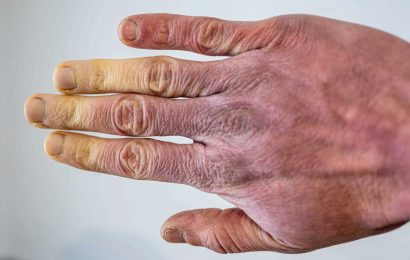Imagine an on-the-road concert documentary shot in the anything-goes days of 1970 — a hurly-burly vérité jamboree like “Mad Dogs & Englishmen” or “Elvis on Tour.” It’s about the biggest rock band in the world. It encompasses 11 shows in 26 days, with headlines and controversies and a film crew out to capture it all. We see the band members backstage, on planes, in their nightly lodgings, and onstage. The crowds are rapturous.
“What the Hell Happened to Blood, Sweat & Tears?” is, in a way, that movie. The band that’s on tour, the mighty but fraught Blood, Sweat & Tears, was full of great musicians who most people didn’t know by name. Yet as fronted by the intoxicating huskiness of lead singer David Clayton-Thomas, they emerged from the embers of the counterculture to become one of the first true supergroups. By the time their 1970 tour arrived, Blood, Sweat & Tears were the most popular rock band in America, with a number-one album and a trio of hit singles that remain iconic: “And When I Die,” “You’ve Made Me So Very Happy,” and the joyfully bombastic and lurchy ear worm that was “Spinning Wheel.”
Yet the story of what happened to BS&T in 1970, as the band was coming off its second album (the one with all the hits) and preparing to launch its third (which was peppered with terrific songs like “Lucretia MacEvil” and their disarmingly soulful cover of “Fire and Rain”), remains a singular piece of rock history, even if hardly anyone knows about it. I didn’t know about it, but now that I’ve seen the film I’d call it essential.
As the documentary explains, David Clayton-Thomas was from Canada, where he had grown up as a delinquent troublemaker. As a star, he still had traces of his wild ways; when he was arrested for allegedly threatening a girlfriend with a gun, the U.S. officials decided to deny him his green card. He was going to get kicked out of the country — which meant, in a pop-music landscape even more America-centric than it is now, that the band, in effect, would be finished.
Rather than accept this fate, Blood, Sweat & Tears cut a deal. In an arrangement brokered by the lawyer Larry Greenblatt, they agreed to become the first rock band to play in countries behind the Iron Curtain, in a cultural-exchange tour sponsored by the U.S. State Department. Why would a government headed by Richard Nixon make this offer, even as it was threatening to deny Clayton-Thomas his green card? It was a form of blackmail. The reason that the State Department felt like it needed Blood, Sweat & Tears — maybe more than the band needed them — relates to the special place the group occupied.
In 1970, the revolution was still officially on. (All those middle-class kids hadn’t quite realized yet that they were just…middle-class kids. That would take until about 1971.) Rock ‘n’ roll was still the voice of the revolution, and the counterculture, enraged by the atrocities of Vietnam, despised anything to do with the Nixon establishment. To play ball with the State Department was to make a deal with the devil.
Yet the success of a band like Blood, Sweat & Tears was already knocking down those kinds of perceptions. The band’s members were against the war, but except for the guitarist Steve Katz (who we see in one clip sounding like Dustin Hoffman playing Tom Hayden), they weren’t really political. Offered the chance to salvage their success by spending June and July of 1970 touring Yugoslavia, Romania, and Poland, they thought, “Why not?”
The footage we see makes the case that there was actually a powerful moral reason to do the tour. The State Department, in its blunderbuss way, wanted to open up a kind of détente with the citizens of Communist Eastern Europe. This sort of exchange had actually begun in 1954, but with classical and jazz musicians. So why not rock ‘n’ roll — or more to the point, a rock band that straddled categories in a way that could bridge the free West and the oppressed Eastern Bloc?
Blood, Sweat & Tears were that band. They were both hip and conservative, sexy and straight arrow, with a sound that fused barreling rock & roll and horn-fueled jazz-gone-Vegas showmanship. The band members, as we get to know them (the documentary features interviews with them today, and they look a lot older but really are the same dudes), were basically geeks, too into their roles as musical sidemen to be cool; several of them, like the trombonist Dick Halligan, smoked pipes. And the presence of those horns, which represented its own sort of super-square revolution (Chicago, over the course of its CXXXVII albums, would complete the post-revolutionary takeover), inspired no less a paragon of mainstream America than Andy Williams to introduce the band on his variety show as “a musical group that can get through to almost anybody.”
Blood, Sweat & Tears were so square that they won the Grammy for best album, in 1970, over “Abbey Road.” They were so square that they played at Woodstock but never made it into the movie — though that was because their manager resented the fact they weren’t being paid and ordered the cameras to stop filming. (This happened to a few other bands at Woodstock as well.) They were so square that they were the first rock band to play at Caesars Palace, where they broke Frank Sinatra’s attendance record.
The rock-‘n’-roll-ecstasy-meets-relax-the-’70s-are-here duality of Blood, Sweat & Tears was incarnated by the contradictory charisma of David Clayton-Thomas. He favored skin-tight shirts with tie-dye stripes and leather pants, but he was no hippie. With his longish receding hair and sultry eyebrows and trucker’s build, he was like Joe Don Baker reborn as Elvis’s surly, sleazy bruiser brother, and he sang in an insinuating Mack-truck growl, like a wilder Tom Jones with a hint of Jim Jones. He was mesmerizing.
“What the Hell Happened to Blood, Sweat & Tears?” is, in a funny way, the squarest early-’70s concert film ever made, because the band travels behind the Iron Curtain…and there’s no counterculture! It’s just them performing in these dour countries full of old stone buildings. The Romania of Nicolae Ceaușescu is the most repressive place they visit and, tellingly, the most responsive to their music. They’re shadowed by Communist agents in dark coats peering through holes in newspapers, in what one of the band members compares to a Peter Sellers movie. But the regime is no joke. When the concert crowds get too fired up, the police arrive with German shepherds. But for the Romanians, seeing Blood, Sweat & Tears was nothing short of a catharsis. “The feeling of freedom it exuded was extraordinary,” says one who was there. Says another, “It was a sign for all of Romania that outside the borders there is life, and it is a very free one.”
Those are moving statements, and no one should have been cheering this on more than the American counterculture. Blood, Sweat & Tears brought a new spirit into a repressive place, in much the way that Frank Zappa was described, by Václav Havel, as having done for Czechoslovakia. And BS&T got in trouble for spreading anarchy, especially when Clayton-Thomas kept doing his gong drop (just what it sounds like) to kick off “Smiling Phases.”
But even as this became a genuine act of rebellion, the fact that the band was working for the State Department — i.e., the Man — made them persona non grata among the rock cognoscenti. The headline on David Felton’s Rolling Stone story was “BT&S Turns Back on Communism.” (Felton appears in the film and basically admits that he was full of it.) We see footage of an L.A. press conference after the group’s return, and the media is downright hostile, as if the band had become collaborators rather than artists opening up a door. At their first gig back, in Madison Square Garden on July 25, 1970, Abbie Hoffman leads a Yippie protest, and the great drummer Bobby Colomby recalls how he was assaulted by a bag of horse manure on stage. It was the last gasp of a certain insular ’60s righteousness.
Searchingly directed by John Scheinfeld (“The U.S. vs. John Lennon”), “What the Hell Happened to Blood, Sweat & Tears?” is a tasty and urgent piece of rock history, but in a strange way the film never comes close to answering its own question. Clive Davis, who first signed the band to Columbia, is on hand to testify, with his usual eloquence, to what made BS&T special, but even given the slagging off they got in the rock press it’s not as if they vanished. They had a hit in 1971 with “Go Down Gambling.” What really did in Blood, Sweat & Tears wasn’t politics but Clayton-Thomas’s decision, in 1972, to go solo. The band needed every bit of his sweat and swagger. (By the time he rejoined them, in 1975, it was too late.) “What the Hell Happened to Blood, Sweat & Tears?” tells a succulent story, but it also captures a moment that was, perhaps, destined to be no more than a moment. As the commentator David Wild observes, what comes up must come down.
Read More About:
Source: Read Full Article







